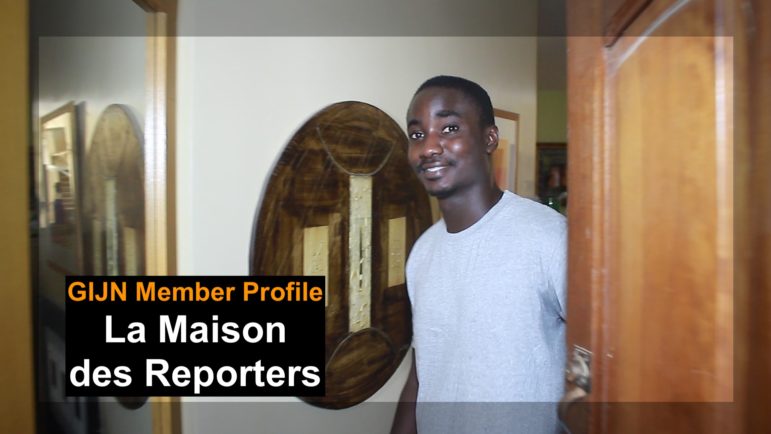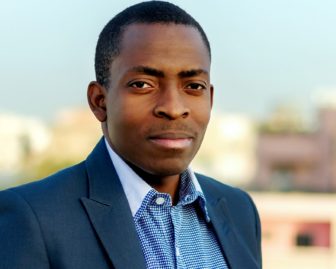
La Maison des Reporters founder Moussa Ngom. Image: Courtesy of Ngom
La Maison des Reporters (LMDR) was barely two years old when it was admitted as a member of GIJN in December 2021. The rise of this young media organization is the story of an uncommon passion among people who, in their twenties, rallied around founder Moussa Ngom to practice journalism differently in Senegal.
A West African nation of 17 million, French-speaking Senegal enjoys more freedoms than most countries in the region, and its press has a longstanding reputation for independence. Ranked 49th in the Reporters Without Borders World Press Freedom Index in 2021, the country is far ahead of its few immediate neighbors, such as Guinea (109th), Mali (99th), and Mauritania (94th).
However, Senegal’s press climate still has its problems. “With a few exceptions, the majority of the media is concentrated in the hands of businessmen, politicians, and religious lobbies who only accept the media they control,” says media expert Hamadou Tidiane Sy, who is also a founder of E-jicom, a journalism school in Dakar.
Trouble in Traditional Media
In early 2021, both public and private media outlets were attacked, and some of their journalists threatened with death. The attackers were unhappy with the press’s reporting on a political opposition leader, who was accused of raping a young girl in a massage parlor. The intense coverage of this case dominated the country’s media landscape for months — and it revealed one of the core problems facing the Senegalese press.
“Here, the media are more focused on the news of the political field; the power struggles and everything that goes with it,” laments Ngom. “All aspects related to public life are left out.”
Ngom, who is just 28 years old, did not need many years working in traditional media to convince himself that he didn’t fit in. In 2017, while a student at the Dakar-based journalism school CESTI (Center for Information Science and Technical Studies), he interned for one of the country’s largest media groups. What he found did not meet his expectations.
“The way they were structured did not fit my ideal of journalism,” Ngom recalls. “For example, I was in charge of producing features, but it was a huge challenge to produce them. I had to face a lack of resources, the hyper-productivity [the pace of work imposed on journalists], and I realized that I could not flourish with that model.”
Going Independent
The young student then took his first step on a path that eventually led to the creation of the first, fully participatory independent media site in the country. He created a blog and traveled around the country, reporting on what he encountered to feed his “road book” section. He practiced his own ideal of what journalism should be. He also built a reputation, gathered field experience, and won awards.
Though he considered freelancing to further his journalism career, he quickly abandoned the idea. “For a radio story, the rate is 2,500 FCFA (about US$4.15), which is totally derisory,” Ngom explains.
Instead, he chose to experiment with the participatory model — crisscrossing Dakar with subscription cards to sign-up readers for his blog. The income from these subscriptions wasn’t enormous, but it allowed him, for example, to buy a phone and to finance his reporting.
Though the quality of his reporting won him awards and attracted young journalists, some veteran news professionals and members of Senegal’s traditional media remained skeptical.
“There was my director at the school of journalism who told me that, in any case, he did not think that this project would go far,” Ngom recalls. “I received a call from a colleague who told me that the Senegalese public was not ready for this kind of project, that it would not prosper.”
Launching a Groundbreaking Network

Image: Screenshot
On September 30, 2019, surrounded by a dozen young journalists inspired by his independent approach, Ngom launched “La Maison Des Reporters” (The House of Reporters) at a press conference. Since then, the group has grown even larger, and experienced success, he says, beyond their expectations. While most of LMDR’s initial staff were journalists under 30, the site’s independence also attracted other, more experienced reporters. “They had the same ideas, but had not been able to do it — and, since I had done it, they joined the project to be able to concretize a mission they felt invested with,” Ngom says.
Still, LMDR’s launch showed the financial challenges of being a pioneer in a country with traditional media funded mostly by the powerful. Though the site’s goal was to raise $36,000 in its initial crowdfunding campaign, it was only able to bring in $3,000, roughly 10% of its target.
“Even so, I said to myself that we would still launch the project with some adjustments, with much more flexible conditions that would allow journalists to come and do their story and leave,” Ngom says. “Thus, we were able to continue to exist.”
As a result of this model, La Maison Des Reporters does not have a permanent newsroom. It is managed more like a network of reporters, who share certain values and a vision for journalism. For them, it is necessary to pursue fact-based field reporting, and to move away from “Wasahala” — a popular talk show format in traditional Senegalese media, in which guests argue and share their opinions on politics and news.
Initially carried by a dozen founding members, LMDR is run according to a flexible structure that continues to evolve depending on available resources. For now, the nonprofit mainly revolves around Ngom, who is its coordinator and the only full-time member. He is assisted by a non-permanent assistant, and about 15 members who are called “mentors.” In March 2022, the linchpin of the organization was made up of more than 100 reporters — members who might be linked to other for-profit newsrooms or working as freelancers.
The daily rhythm of La Maison Des Reporters works like this: freelancers or reporters pitch investigations or long-form stories that they do not have the opportunity or the means to cover elsewhere. More experienced journalists evaluate these pitches and, if approved, the organization offers both editorial support and decent pay (LMDR typically covers an average of $300 in expenses, as well as a freelancing fee aligned with the local journalists’ labor agreement.) LMDR also publishes the story or investigation once it is completed.
The site’s work — which can include written, audio, or multimedia stories — has already won five regional and international prizes.
One of those award-winning journalists is Ass Momar Lô. His audio investigation on migration in Senegal, broadcast by LMDR at the end of 2021, won the Norbert Zongo African Prize of Investigative Journalism, and was selected as a GIJN Editor’s Pick for being among the best investigations in Francophone Africa last year. “It’s about in-depth journalism,” Lô explains, “guided by the sole concern of informing the public in complete independence and transparency.”
Serving—and Funded by—the Public
One of the most prestigious investigative media sites in the Francophone world today is France’s Mediapart. It has built a strong reputation as a news organization funded by subscriptions, rather than advertising, which has given it the freedom to reveal some of the country’s biggest political scandals of the past decade. In Senegal, many observers characterize LMDR as the local Mediapart, and point to the ambition of many young Senegalese journalists to operate only on subscriptions. But the context and the level of literacy among readers differ.
“When it came to founding La Maison des Reporters, there were two models that influenced me,” Ngom explains. “Often, we are compared to Mediapart, but its influence was more related to their ideal of independence, and their format. But in terms of the business model, it was the Guardian (UK) that influenced me the most. This model consists of making access to content free.”
“We cannot hide the content behind a paywall when it is meant for a population that cannot afford a subscription fee — while at the same time we want to have an impact on this population through the quality of information we provide,” Ngom adds. “For us, the most appropriate [model] was that access was free for all, and that the contribution was voluntary.”
La Maison Des Reporters is the first media organization in Senegal to commit to relying exclusively on reader subscriptions, notes Hamadou Tidiane Sy. “This is a model to be encouraged,” he says. “We need more of them in the Senegalese landscape.”
Ngom notes that the majority of LMDR’s 400 current subscribers, who pay monthly rates of roughly $1, $2 or $4, are under the age of 30. But the revenue from subscriptions by the diaspora and older segments of the population remains the highest. And the goal, according to Ngom, is to quickly reach 3,000 subscribers, which would allow them to secure a minimum annual budget of $35,000, increasing their capacity to produce more ambitious stories.
In addition to refusing advertising revenue, the organization, to date, has also excluded grants from foundations and other nonprofit funders, to keep its focus squarely on its target audience. The goal, Ngom says, “is to link the salvation of the media with the people that it serves.” He adds: “It is necessary to have the public be actively involved in the financing and the development of the independent media.”
Additional Resources
The Tunisian Journalists Who Built a Business Model That Frees Them to Investigate
From Traditional Journalism to Sustainable Journalism
How Africa Confidential Covers the Continent with a Subscription Model that Works

Maxime Domegni is GIJN’s Francophone Africa editor and an award-winning journalist with years of experience in investigative journalism. Previously, he was editor-in-chief of the Togolese investigative newspaper L’Alternative. Based in Dakar, Senegal, he worked for several years for BBC Africa as a journalist and planning producer for French-speaking Africa.
